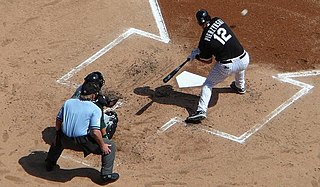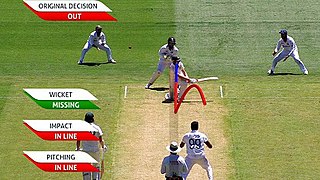
Bowling, in cricket, is the action of propelling the ball toward the wicket defended by a batter. A player skilled at bowling is called a bowler; a bowler who is also a competent batter is known as an all-rounder. Bowling the ball is distinguished from throwing the ball by a strictly specified biomechanical definition, which restricts the angle of extension of the elbow. A single act of bowling the ball towards the batsman is called a ball or a delivery. Bowlers bowl deliveries in sets of six, called an over. Once a bowler has bowled an over, a teammate will bowl an over from the other end of the pitch. The Laws of Cricket govern how a ball must be bowled. If a ball is bowled illegally, an umpire will rule it a no-ball. If a ball is bowled too wide of the striker for the batsman to be able to play at it with a proper cricket shot, the bowler's end umpire will rule it a wide.
In cricket, an umpire is a person who has the authority to make decisions about events on the cricket field according to the Laws of Cricket. Besides making decisions about legality of delivery, appeals for wickets and general conduct of the Game in a legal manner, the umpire also keeps a record of the deliveries and announces the completion of an over.

A referee is an official, in a variety of sports and competition, responsible for enforcing the rules of the sport, including sportsmanship decisions such as ejection. The official tasked with this job may be known by a variety of other titles depending on the sport, including umpire, judge, arbiter (chess), commissaire, or technical official. Referees may be assisted by umpires, linesmen, timekeepers, touch judges, or video review officials.
The Laws of Cricket is a code that specifies the rules of the game of cricket worldwide. The earliest known code was drafted in 1744. Since 1788, the code has been owned and maintained by the private Marylebone Cricket Club (MCC) in Lord's Cricket Ground, London. There are currently 42 Laws, which describe all aspects of how the game is to be played. MCC has re-coded the Laws six times, each with interim revisions that produce more than one edition. The most recent code, the seventh, was released in October 2017; its 3rd edition came into force on 1 October 2022.

In cricket, the stumps are the three vertical posts that support the bails and form the wicket. Stumping or being stumped is a method of dismissing a batsman.

This is a general glossary of the terminology used in the sport of cricket. Where words in a sentence are also defined elsewhere in this article, they appear in italics. Certain aspects of cricket terminology are explained in more detail in cricket statistics and the naming of fielding positions is explained at fielding (cricket).

In the game of baseball, the official scorer is a person appointed by the league to record the events on the field, and to send the official scoring record of the game back to the league offices. In addition to recording the events on the field such as the outcome of each plate appearance and the circumstances of any baserunner's advance around the bases, the official scorer is also charged with making judgment calls that do not affect the progress or outcome of the game. Judgment calls are primarily made about errors, unearned runs, fielder's choice, the value of hits in certain situations, and wild pitches, all of which are included in the record compiled. This record is used to compile statistics for each player and team. A box score is a summary of the official scorer's game record.
Dead ball is a term in many ball sports in which the ball is deemed temporarily not playable, and no movement may be made with it. Depending on the sport, this event may be quite routine, or more uncommon.

In cricket, an extra is a run scored by, or awarded to, a batting team which is not credited to any individual batsman. They are the runs scored by methods other than striking the ball with the bat.
Baseball and cricket are the best-known members of a family of related bat-and-ball games. Both have fields that are 400 feet (120 m) or more in diameter between their furthest endpoints, offensive players who can hit a thrown/"bowled" ball out of the field and run between safe areas to score runs (points) at the risk of being gotten out, and have a major game format lasting about 3 hours.
Law 41 of the Laws of Cricket covers unfair play. This law has developed and expanded over time as various incidents of real life unfair play have been legislated against.
Instant replay or action replay is a video reproduction of something that recently occurred which was both shot and broadcast live.

A checked swing is a type of motion in baseball made by a batter. A checked swing occurs when a batter starts to swing the bat at the ball, but stops the swing in order to allow the ball to pass without hitting it. If the swing was indeed checked, so that there was no swing, and if the bat did not touch the ball and it did not go through the strike zone, the pitch counts as a ball; but in that circumstance if the swing was not checked, so that a swing occurred, then the pitch counts as a strike.

The laws of Australian rules football were first defined by the Melbourne Football Club in 1859 and have been amended over the years as Australian rules football evolved into its modern form. The Australian Football Council (AFC), was formed in 1905 and became responsible for the laws, although individual leagues retained a wide discretion to vary them. Following the restructure of the Victorian Football League's competition as a national competition and the League's renaming to be the Australian Football League (AFL), since 1994, the rules for the game have been maintained by the AFL through its Commission and its Competition Committee.

A free kick in Australian rules football is a penalty awarded by a field umpire to a player who has been infringed by an opponent or is the nearest player to a player from the opposite team who has broken a rule.

In baseball, a baserunner is safe when he reaches a base without being put out by various ways. While a runner is touching a base, he is usually not in jeopardy of being put out, and is thus "safe" from fielders' actions, such as tags. The runner is in jeopardy once again, negating this safety, when:
Crocker is a team sport played between two large teams. Its origins are in cricket and baseball. It also makes the use of a rugby ball, or a soccer ball which may explain its name. It is a casual sport not played formally, but often found on British summer camps.

In basketball, an official enforces the rules and maintains order in the game. The title of official also applies to the scorers and timekeepers, as well as other personnel that have an active task in maintaining the game. Basketball is regarded as among the most difficult sports to officiate due to the speed of play, complexity of rules, the case-specific interpretations of rules, and the instantaneous decision required.

Hot Spot is an infrared imaging system used in cricket to determine whether the ball has struck the batsman, bat or pad. Hot Spot requires two infrared cameras on opposite sides of the ground above the field of play that are continuously recording an image. Any suspected nick or bat/pad event can be verified by examining the infrared image, which usually shows a bright spot where contact friction from the ball has elevated the local temperature. Where referrals to an off-field third umpire are permitted, the technology is used to enhance the on-field umpire's decision-making accuracy. Where referrals are not permitted, the technology is used primarily as an analytical aid for television coverage.

The Decision Review System (DRS), formerly known as the Umpire Decision Review System(UDRS), is a technology-based system used in cricket to assist the match officials in their decision-making. On-field umpires may choose to consult with the third umpire (known as an Umpire Review), and players may request that the third umpire consider a decision of the on-field umpires (known as a Player Review).












